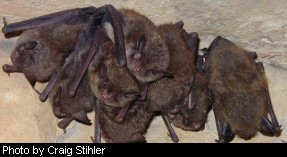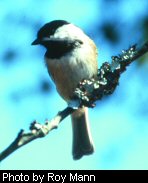

The Big SleepBy Sue Olcott Hibernation is an extreme form of inactivity or torpor — a profound lowering of an animal's body temperature and metabolism to save energy. It is similar to lowering the thermostat in your house to save on heating costs. Instead of fossil fuels or wood, though, stored fat is the energy source the animal is using and trying to conserve during torpor. In this part of North America, an animal usually enters torpor because its regular food source has become scarce or because it cannot survive harsh weather conditions, or both. Places where animals hibernate, called hibernacula , range from caves and old mines, to burrows dug beneath the frost line, to basements and crawlspaces in buildings. Each species has a specific range of environmental conditions that need to be met within the hibernaculum . These factors typically include temperature, humidity, safety from predators and, for some, space to store food. Many animals enter into a short-term or daily torpor as a matter of course. During cold winter nights, a chickadee typically allows its body temperature to fall 10 to 15 degrees. This lowering of the thermostat requires less energy to maintain and literally allows a chickadee to survive, for it cannot store enough fat to maintain its normal body temperature through a cold winter night. If it tried, it would starve. Chickadees are one of the earliest risers because they need to replenish their depleted fat stores. They relish black-hulled sunflower seeds, suet and peanut butter because these high-energy foods aid their precarious winter survival. During long summer days, bats must fast up to 15 hours - and even longer further north. A lowered body temperature means less energy is being used to maintain important body functions like breathing, digestion, blood circulation and, for females with young, milk production. Bats often seek out roosts that provide them with a range of temperatures that they can move into depending on their needs. Male bats may use roosts that are cooler early in the day so they can lower their body temperature and conserve energy, and warmer late in the day to help them raise their body temperature in preparation for flight and feeding. Females with young may use roosts that remain very warm throughout the day to keep the body temperatures of their offspring high to help them grow more quickly. Hibernators differ from animals that enter daily torpor because the decrease in body temperature and other functions is much greater. For example, a hibernating little brown bat's body temperature drops to near freezing, breathing decreases to less than one breath per minute, and the heart rate slows from 400 to 25 beats per minute. True hibernators also stay in this state longer at a stretch than animals that don't hibernate — in some ground squirrels 30 days and in bats up to 83 days. Most of the energy a hibernating animal expends during the winter is used to periodically rouse the body to allow it to perform certain tasks such as urination, which is impossible at lower temperatures. A single waking period of a few hours in a bat can use as much stored fat as 67 days of hibernation. These waking periods also take a long time to achieve — up to 30 minutes for a bat and several days for a woodchuck. Hibernators walk a thin line between how often they wake up and the amount of fat they store. If they are disturbed or wake too many times, or if the winter is especially long, they will run out of fat reserves and starve. In most species that hibernate, a significant cause of mortality is death during hibernation. Those that succumb may have stored too little fat to sustain them through the hibernation period or have chosen a hibernaculum that was too cold or too dry. A hibernaculum that is too dry may cause the animal to lose too much water vapor during respiration, resulting in death.
Some of our common hibernators are chipmunks, woodchucks, little brown and pipistrelle bats, snakes, frogs and toads, and many insects. In two orders of mammals, the rodents and the bats, development of hibernation enabled these groups to become highly successful — inhabiting almost all ecosystems on earth and collectively numbering over half of all mammalian species. A common misconception is that bears hibernate. While it is true that bears are inactive for much of the winter, they are not true hibernators. Although they sleep for weeks at a time, their body temperature only drops 10 to 15 degrees, and they can wake up very quickly, as any researcher working with bears will tell you. They also bear their young during this time, an activity that requires them to produce milk — a process impossible in true hibernation. Other of our winter residents such as raccoons, fishers and deer mice sleep for varying periods of time through the worst weather when foraging for food is all but impossible. In all of these animals, different degrees of torpor help to conserve their energy stores so they can survive until spring returns with its abundant food supply and milder weather conditions. Sue Olcott is a DNR wildlife biologist stationed in Fairmont. |
 During this time of year we become more aware of the difficulties wild animals must overcome to survive in West Virginia. Trees are dropping their leaves. Days are quiet since most song birds have migrated south to find food and escape the coming cold. Deer are increasing the thickness and length of their coats as protection from the cold. Some animals have disappeared like the songbirds — but they haven't migrated. They are involved in an equally amazing process called hibernation.
During this time of year we become more aware of the difficulties wild animals must overcome to survive in West Virginia. Trees are dropping their leaves. Days are quiet since most song birds have migrated south to find food and escape the coming cold. Deer are increasing the thickness and length of their coats as protection from the cold. Some animals have disappeared like the songbirds — but they haven't migrated. They are involved in an equally amazing process called hibernation.  The length of time that an animal remains in its hibernaculum depends in large part upon its elevation above sea level and its latitude. Marmots, western relatives of woodchucks, enter hibernation earlier and emerge later at higher, and therefore colder and harsher, elevations. Franklin's ground squirrel, a species common in the high prairies of the United States and Canada, has a hibernation period that ranges from seven to eight months depending upon its latitude. Additionally, in many species, adults enter hibernation first. The young, eating and growing as fast as they can, may enter hibernation months later because they can not store enough fat to survive hibernation until they have reached their adult size.
The length of time that an animal remains in its hibernaculum depends in large part upon its elevation above sea level and its latitude. Marmots, western relatives of woodchucks, enter hibernation earlier and emerge later at higher, and therefore colder and harsher, elevations. Franklin's ground squirrel, a species common in the high prairies of the United States and Canada, has a hibernation period that ranges from seven to eight months depending upon its latitude. Additionally, in many species, adults enter hibernation first. The young, eating and growing as fast as they can, may enter hibernation months later because they can not store enough fat to survive hibernation until they have reached their adult size.